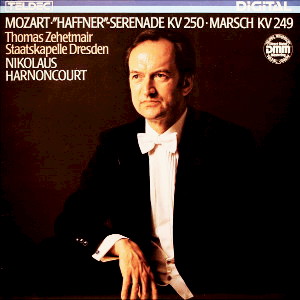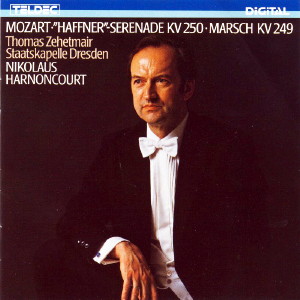 |
1 LP -
6.43062 AZ - (p) 1985
|
 |
| 1 CD -
8.43062 ZK - (p) 1985 |
|
| Wolfgang
Amadeus Mozart (1756-1791) |
|
|
|
|
|
|
|
| Marsch D-dur, KV 249 |
|
|
|
| - Maestoso |
|
3' 31" |
A1 |
Serenade Nr. 7 D-dur, KV 250
(248b) "Haffner-Serenade"
|
|
57' 22" |
|
- Allegro maestoso - Allegro
molto
|
9' 01" |
|
A2 |
| - Andante
* |
10' 40" |
|
A3 |
| - Menuetto - Trio * |
3' 31" |
|
A4 |
| - Rondeau: Allegro * |
8' 04" |
|
A5 |
- Menuetto galante
|
6' 05" |
|
B1 |
| - Andante |
6' 54" |
|
B2 |
- Menuetto - Trio I - Trio
II
|
4' 52" |
|
B3 |
- Adagio / Allegro assai
|
8' 15" |
|
B4 |
|
|
|
|
| Thomas
Zehetmair, Solo-Violine
* |
|
| Staatskapelle
Dresden |
|
|
|
| Nikolaus
Harnoncourt, Dirigent |
|
|
Luogo
e data di registrazione
|
Studio
Lukaskirche, Dresda (Germania) - 1984
|
|
Registrazione
live / studio
|
| studio |
Producer
/ Engineer
|
Heinrich
J. Weritz / Helmut A. Mühle / Martin
Foquè / Michael Brammann
|
Prima Edizione CD
|
| Teldec
- 8.43062 ZK - (1 cd) - 61' 13" - (p)
1985 - DDD |
Prima
Edizione LP
|
Teldec - 6.43062
AZ - (1 lp) - 61'
13"
- (p) 1985 - Digital
|
|
Nota
|
| Co-Produktion
mit VEB Deutsche Schallplatten,
Berlin/DDR |
|
|
Notes
|
The Serenade in D major K.
250 occupies a special place among
Mozart’s serenade works. Its compositional
weight and quite exceptional
length force the commentator to
make separate pronouncements on
the stylistic value of the work
and on its place in musical
sociology, while bearing in mind
those features characteristic of
the serenade genre. One of these
is the gay, festive prevailing
mood, together with the
standardized movements that
remained typical of Mozart’s
serenade compositions. Mozart
follows this basic mood - broken
from time to time by that
ambivalence of feeling that tends
to be de rigeur in his
compositions in the major - in an eight-part
sequence of standard movements,
which manages to sublimate the
music’s entertainment and
seduction value - be it
representative and symphonic
(Allegro maestoso - Allegro
molto), dance-like (“Menuetti”) or
dreamy - on the level of absolute
technical mastery.
The “Haffner” Serenade, then, is
utterly representative of the
serenade model in many atmospheric
elements and in its economy of
motion. The concerto movements
embedded in the piece, however, in
close relation to the Work’s radical
dimensions, cannot help but awaken
further philological interest.
Movements 2 to
4 (Andante, Menuetto, Rondo) are
redolent in their structure of a
“violin concerto" within the work,
the solo violin being allocated
precisely that role that it
normally fills in a concerto
dialogue. Thus the Serenade and
concerto models are combined,
extending the scope for definition
both within each
movement and from one section of
the work to another. This is
particularly apparent in the
layout of the concerto “finale”
(rondeau), in the course of which,
in opposition to other rondo
proclamations, Mozart creates a
conspicuous link between the
so-called couplets and the main
idea. Walter
Senn writes on
this device in
the New Mozart Edition: “Whereas
in normal rondo form the
ritornello represents the main idea and the episodes (couplets) the
subordinate idea, Mozart creates
an inner link here by placing the
episodes as four
variations between
the five ritornelli.” Incidentally,
concerto interludes were not
limited to this one instance in
the larger Salzburg serenades.
Clearly, though, in the case of
the “Haffner”, a degree of
annoyance at the scale of the work
and the particularly prominent
concerto section made itself felt,
as is shown by the very fact that
a curtailed version
- omitting
just these passages dominated by the violin -
has survived, and is indeed
included in the seventh volume of
the symphonies in the New Mozart
Edition.
Mozart’s Serenade K. 250 was
written to the commission of the
Salzburg merchant Siegmund
Haffner. It
formed the musical accompaniment
to the festivities on the eve of
his sister Marie Elisabeth’s
marriage to Franz Xaver Späth, a merchant
from South Tyrol. The musicians
played the March K. 249 as they
made their way towards the Paris-Lodron-Gasse in
Salzburg, and the present recording
rcflects this
custom.
Peter Cossé
Translation: Clives
Williams
|
|
Nikolaus
Harnoncourt (1929-2016)
|

|

|
|